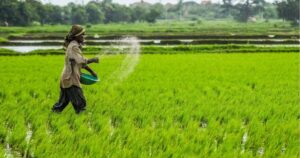Potash (K), and phosphate (P) are among the three major plant nutrients (the third being nitrogen or ‘N’) needed for increasing the production of foodgrains and other agricultural products. Their requirements are met mostly from imports.

A farmer sprinkles fertiliser on paddy crop in Koppal district.
The enactment of two laws, viz. the Mines and Minerals (Development and Regulation) Amendment Act, 2023, and the Offshore Areas Mineral (Development and Regulation) Amendment Act, 2023, in the monsoon session of Parliament bodes well for the Indian fertiliser sector. While the first law paves the way for the auction of critical minerals such as potash and phosphate blocks for exploration and processing in India, the second law provides a fixed 50-year production lease for offshore minerals.
Potash (K), and phosphate (P) are among the three major plant nutrients (the third being nitrogen or ‘N’) needed for increasing the production of foodgrains and other agricultural products. Their requirements are met mostly from imports. In the ‘K’ sector, India depends entirely on imports coming mostly from Belarus, Canada, Russia, Israel, and Jordan. In ‘P’, our import dependence is almost 80%-90%, with imports coming mainly from China, Saudi, Morocco, Jordan and Egypt.
Together with the import in the ‘N’ segment, where also import dependence is significant, India spends heavily on imported fertilisers. During 2021-22, the total value of fertiliser imports, inclusive of inputs used in domestic production, was $24.3 billion or close to Rs 2,00,000 crore.
India’s vulnerabilities due to its heavy reliance on imports are heightened because of a few countries supplying our needs. In the ‘K’ sector, Russia and Belarus alone contribute 50% of our import requirements. The disruption in supplies and the skyrocketing prices triggered by the Ukraine war made us pay heavily during 2022-23.
India doesn’t have fertiliser resources. This is primarily because, in the past, our policy-makers never bothered to prop up indigenous exploration efforts. Besides, the eco-system under which the fertiliser industry in India operates hasn’t been conducive. This has to do with the Union government asking manufacturers and importers to sell fertilisers at a price much below the cost of supply and compensating them for the differential amount.
Farmers don’t bother to improve the efficiency of use as they are assured of getting fertilisers at a low price. The suppliers know that excess of the cost over the price paid by farmers would be reimbursed as a subsidy, so they don’t mind incurring higher costs. And, global suppliers know that even if they charge high prices, they won’t face demand resistance as the Centre is there to pick up the tab.
Above all, with all stakeholders getting full immunity from the cost push (albeit imported), there is no compulsion to look for resources within the territorial bounds of India.
Another flaw in the policy approach deserves mention.
Before 1991 when a major economic crisis engulfed India, all fertiliser types were meted out similar treatment in as much as all suppliers got subsidies on a ‘firm specific’ basis. In 1991, when we sought the help of the IMF/World Bank, the latter insisted on the elimination of fertiliser subsidies within three years.
The then PV Narasimha Rao government settled for the removal of subsidy on ‘P’ and ‘K’ (non-urea fertilisers) even while retaining control and subsidy on urea. Those decisions were made effective from August 25, 1992. But, within a little over one month, i.e. from October 1, 1992, the subsidy was restored on the former. Under its new incarnation, all suppliers of non-urea fertilisers were given a ‘uniform’ subsidy even as the subsidy on urea continued to be ‘firm–specific’.
Today, all fertiliser types receive subsidies. But, thanks to the control tab on urea, they receive a more favourable treatment than non-urea fertilisers. This has led to much higher prices of the latter vis-à-vis the former. As a result, there is excessive use of ‘N’ vis-à-vis ‘P’ and ‘K’ even as the present NPK use ratio at 6.7:2.4:1 (against the desired 4:2:1) is tilted in favour of ‘N’ — not a healthy sign for soil health and the environment.
Why can’t demand resistance for ‘P’ & ‘K’ fertilisers propel their suppliers to rethink their strategies?
This won’t happen as long as there is government intervention. For instance, even if a supplier brings muriate of potash (MOP) at a lower cost, the government can reduce the subsidy, hence no incentive. That apart, since 2021-22, the Modi government has substantially hiked subsidies on non-urea fertilisers to offset the steep increase in their cost triggered by the Ukraine war, as is the case with urea.
During 2022-23, of the total subsidy bill of Rs 2,55,000 crore, it spent Rs 86,000 crore on these fertilisers (read non-urea). This has only added to the complacency amongst all stakeholders.
The aforementioned laws can help attract investment in the mining and processing of ‘P’ and ‘K’ reserves, particularly in Rajasthan, besides exploring these from under the sea. The government should also overhaul the eco-system for fertilisers by dismantling the extant controls, giving suppliers pricing freedom and subsidies directly to farmers.
(The writer is a policy analyst)
https://www.deccanherald.com/opinion/self-reliance-in-fertilisers-2699243